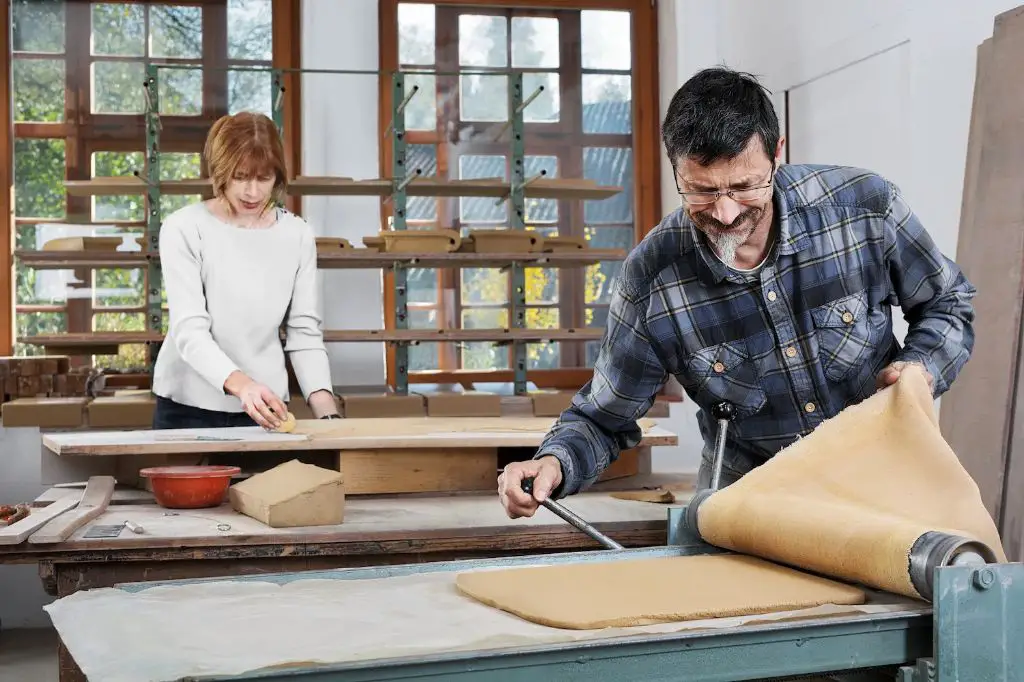What Is A Slab Roller For Clay?
What is a Slab Roller?
A slab roller is a piece of equipment used in working with clay. It consists of two large rollers mounted in a sturdy frame. Clay slabs are fed between the rollers to compress and flatten them into consistent thicknesses (source).
Slab rollers typically have a hand crank or electric motor to drive the rollers. The distance between the rollers can be adjusted to control the thickness of the clay slabs produced. Rollers are often made of steel or hard rubber. The rollers flatten the clay into large, flat slabs evenly and efficiently.
Slab rollers first emerged in the early 20th century as an easier method of producing large flat slabs compared to rolling by hand. They allowed potters to create consistent thicknesses and save time and effort. Today, slab rollers are widely used in pottery studios to make slabs for handbuilding techniques like slab construction (source).
What is it Used for?
Slab rollers are primarily used for flattening and compressing clay slabs into smooth, even, and consistent sheets of clay with uniform thickness (1). This allows potters and ceramic artists to easily roll out large, flat slabs of clay that can then be used to construct various projects.
Some of the main uses of a slab roller include:
- Rolling clay into sheets for handbuilding and slab construction techniques like slump molds, hump molds, and draping molds.
- Creating even, smooth clay slabs for making tiles, plaques, and flat pieces.
- Producing large, consistent sheets of clay for projects like large bowls, platters, and vessel forms.
- Flattening thicker chunks and balls of clay into thinner, more workable slabs.
The compression provided by a slab roller removes air bubbles and creates dense, smooth clay slabs that have an even thickness across the entire sheet. This allows potters to roll out clays like stoneware, porcelain, and terra cotta to their desired thinness for constructing ceramics (1).
Sources:
(1) https://thepotterywheel.com/what-is-a-slab-roller/
Advantages

Using a slab roller has several key advantages over rolling clay slabs by hand:
It saves a significant amount of time compared to rolling slabs manually. A slab roller can produce a large, uniform slab in just a few minutes, whereas doing it by hand with a rolling pin takes much longer.
Slab rollers create very uniform slabs with an even thickness throughout. This consistency is hard to achieve through hand rolling. The rollers apply even pressure across the entire slab.
Slab rollers can make extremely large slabs, bigger than what is feasible to create by hand. Some commercial slab rollers can produce slabs up to 24 inches wide and of any length.
Overall, slab rollers greatly improve efficiency and enable potters to work on a much larger scale than hand rolling methods allow.
Disadvantages
Though slab rollers can be very useful tools, they do come with some drawbacks to consider:
Slab rollers can be expensive equipment, with prices ranging from a few hundred to several thousand dollars depending on the model and features. This significant upfront cost may put them out of reach for some potters or studios (Ceramic Slab Roller – Complete Guide).
These machines also take up a good amount of space in the studio. Their large footprint means you’ll need enough floor area to accommodate the slab roller and work around it comfortably (clayart – thread ‘pros and cons of slab rollers needed’).
Finally, slab rollers tend to have limited thickness adjustment options. Most models only allow you to choose between a few preset thicknesses. So you won’t have the same flexibility as hand rolling slabs to any custom thickness (slab rolling problems).
Types of Slab Rollers
There are two main types of slab rollers – manual and electric. Manual slab rollers are operated by a hand crank or lever and require physical effort to roll out the clay. Electric slab rollers are powered by an electric motor and make the rolling process much easier, allowing clay artists to work faster. Within both categories, slab rollers come in a range of different widths from small tabletop models to large industrial sizes. Wider rollers are generally recommended as they can accommodate larger slabs.
Some slab rollers also have special texture rollers that can imprint patterns onto the clay. These texture rollers have designs like waves, zig zags, diamonds, etc. carved into them. As the clay slab passes through the textured roller, it picks up the imprint on its surface. This allows clay artists to add decorative effects to their slabs for more visual interest. Using texture rollers requires a bit more pressure when rolling and may require conditioning the clay specifically for imprinting textures.
In summary, the key factors differentiating slab roller types are:
- Manual vs. Electric
- Roller width
- Availability of texture rollers
Considering your needs and budget will help determine what slab roller is the right fit for your clay projects.
Important Features
Some key features to look for when selecting a slab roller include:
Adjustable thickness – Slab rollers allow you to adjust the space between the rollers to produce slabs of different thicknesses. Look for slab rollers that offer a wide range of adjustable heights such as from 1/8″ up to 1″ or more.
Width of roller – The wider the roller, the larger the slab of clay you can produce in one pass. Common widths range from around 12-24 inches. If you want to make large slabs, opt for a slab roller with a wider roller.
Sturdy construction – As you’ll be applying significant pressure, the slab roller needs to be made of metal and able to withstand regular use without flexing or bending. Heavy duty cast iron or steel frames are ideal.
Safety features – Given the moving parts, look for safety features like finger/hand guards and emergency stop buttons. Some models even have electronic sensors that stop the machine if hands get too close.
Other considerations are the motor power, ease of cleaning, and any included accessories or tables. Carefully reviewing the product specifications will help you choose the right slab roller for your needs and budget.
Brands & Models
Some of the most popular slab roller brands for ceramic artists include Brent, Amaco, and Bailey. Here’s an overview of top models and prices:
Brent
Brent is one of the leading manufacturers of pottery equipment in the USA. Their slab roller models include:
- Brent C, starting at $1,299 – A heavy-duty electric model good for studios
- Brent B, starting at $899 – A lightweight benchtop model for home studios
- Maxi-Roller, starting at $3,195 – An extra wide model for large slabs
Amaco
Amaco is another major supplier for ceramic artists. Their main slab roller models are:
- Amaco Steel Roller – A manual roller priced at around $300
- Amaco Electric Roller – Starts at $1,200 with variable speed control
Bailey
Bailey offers quality manual slab rollers such as:
- Bailey POTTERY ROLLER – A fiberglass roller for $359
- Bailey HEAVY Steel Roller – A heavy-duty metal roller for $489
Accessories
In addition to the slab roller itself, there are several accessory items that can enhance the use of a slab roller or make working with slabs easier:
Canvas Sheets
Canvas sheets placed on top of the slab roller provide an ideal rolling surface. The canvas helps absorb moisture from clay slabs and prevents them from sticking to the roller. Canvas sheets are reusable and washable.
Rolling Pins
Rolling pins come in various materials like wood, acrylic, or metal. They help roll out clay to an even thickness and can impart decorative patterns. Using a rolling pin on top of slabs provides added pressure.
Texture Rollers
Texture rollers are cylinders with various surface patterns to imprint designs onto clay slabs. They add visual interest and dimension. Some common texture rollers include mesh, gears, burls, waves, rings, etc. Using them after the slab roller gives slabs decorative effects.
Using & Maintaining
Proper setup and maintenance are important for getting the most out of your slab roller and ensuring its longevity. Here are some tips:
Setup and Leveling – Slab rollers should be set up on a sturdy, level surface to prevent wobbling and uneven rolling. Use a level to check that the table is flat and make any necessary adjustments to the legs or feet.
Cleaning After Use – After each use, thoroughly clean clay residue off all rollers and the rolling surface using a damp sponge or rag. Allow to fully dry before storage. Periodically check for clay stuck in crevices or gears and remove any hardened bits. Avoid hosing down or submerging the slab roller.
Storage– When not in use for extended periods, lightly rub all rollers with machine oil to prevent rusting. Cover the slab roller and store in a dry indoor location away from temperature extremes. Engage the safety lock to prevent rolling parts from moving in storage.
Alternatives
While slab rollers are a popular tool for working with clay, there are some alternatives that can be used in place of a slab roller:
Rolling Pins
A regular rolling pin, like those used for baking, can be used to roll out clay slabs by hand (https://www.reddit.com/r/Pottery/comments/13q3vnf/alternative_to_slab_roller_detail_in_comment/). While it takes more physical effort than a mechanical slab roller, a rolling pin can create slabs with some practice. Choose a heavy rolling pin with a smooth, non-stick surface.
Hand Rolling
It’s also possible to roll clay out into slabs by hand or using a clay mallet. This takes time and effort but can be done. Use a wood, rubber or plastic mallet to pound the clay into a slab shape. A slab stick or yardstick is helpful for rolling an even thickness. Go slowly and be patient when hand rolling slabs.
Clay Extruders
For some applications, a clay extruder can be used as an alternative to a slab roller. Clay extruders force clay out through a die into a long sheet. This creates a slab of even width and thickness. Extruded slabs won’t have quite the same surface quality as rolled slabs, but can work for some projects.


